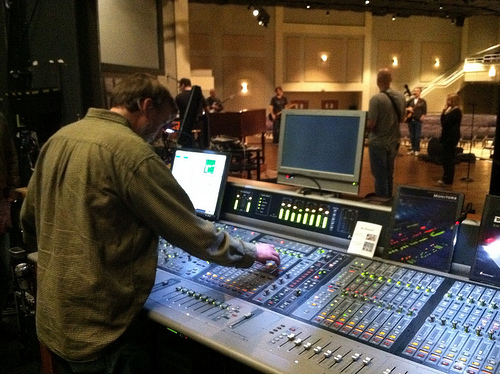
Pitch-Perfect? – Part 2
In my last article I talked a bit about my thoughts on the use of automatic pitch correction. Today I want to talk about a few solutions for dealing with pitchy vocals that don’t involve pitch correction.
There is a knee-jerk reaction I think most people have when someone is singing off key where most people immediately assume that the person can’t sing well. This may be the case in some instances, however, the culprit is sometimes a bit trickier. Poor pitch can be the result of poor monitoring, over-singing, and/or under-singing, and guess what: These are things that we, as engineers, can assist vocalists with.
Let’s start with monitoring. Remember in my last article when I talked about relative pitch? That’s what this is all about. It is imperative for vocalists to have good monitoring so they can hear their own pitch clearly as well as a pitch reference. They also need a good timing reference, but let’s not get into that today since we’re focusing on pitch.
When a vocalist is struggling with pitch, the first place I want to look is their monitors. Does he have enough of himself? Does he have enough of his reference? If a vocalist is struggling to hear either of these clearly, it will be difficult for him to sing in tune. Even with clear monitors, however, we can still have monitor related issues.
When a vocalist’s vocal level to himself is too soft, the vocalist may push too hard. This can result in oversinging and notes consistently going sharp. Similarly, if the vocalist’s level to himself is too loud, the vocalist may not push hard enough. This can result in undersinging where notes consistently go flat. Again, these are two things that making monitor adjustments can help so it’s important for me to find out what’s happening with the monitors.
On a side note, Andy Chrisman from Church on the Move did a couple of great talks on Delivering a Great Vocal Performance at the Seeds Conference a few years back. As memory serves, he talks about how breath control and having enough air to support a note can affect pitch in these talks. So if you have vocals who struggle with pitch, these talks might be worth a listen. I believe you may download them HERE.
Now back to our engineering world.
If the monitors are in good shape, and our vocalists are just not going to have their best day we are not completely out of luck without using pitch correction. Room acoustics, in my experience, often aid in hiding pitch problems. So when the acoustics aren’t enough, employing additional reverb on the vocals can help make a slightly off vocal more listenable.
This brings up another monitor point. If a vocalist is struggling with pitch, reducing or even removing reverb from their monitors could also help them in the opposite way it helps in the room. When I used to perform and used in-ears, I never used reverb in my ears because I read an article where a famous artist at the time mentioned he kept his vocal completely dry in his monitors because it made his pitch much clearer. There was a lot of truth in that article. Not every vocalist will go for this because it is extremely revealing to the singer and unfortunately not every vocalist can handle that kind of honesty in their in-ears. Although, if you’re a vocalist and looking to improve, this isn’t a bad exercise to try.
A split-harmonizer can also help us to some degree as well. What is a split-harmonizer? It’s a classic studio effect maybe most notably employed via an AMS effects box, although, I used to do it using an H3000. The effect is created by duplicating a vocal onto a couple of channels and panning one duplicate hard left and right. Then each side is shifted slightly in pitch and often delayed. These duplicates are then blended in with the original vocal. The result is typically a thicker and wider sounding vocal, and in addition the effect can also help by smearing the pitch of the vocal a bit. There are plug-ins that can create this same effect like Waves Doubler, but you can do it yourself as well. I typically start by setting the pitch up 9 cents on one side and down 9 cents on the other. Then I’ll delay each side differently but somewhere in the neighborhood of 15-20ms. You just have to be careful how much of the effect you push into the mix because it can also create a chorused sounding vocal which may, or may not be what your looking for.
If you’ve got your own unique ways for dealing with pitchy vocals, I’d love to hear about them in the comments. I’ll be back in my next article to talk about the Waves Tune Real-Time plug-in along with some thoughts on when I’m OK resorting to that kind of a tool.


 Previous Post
Previous Post


